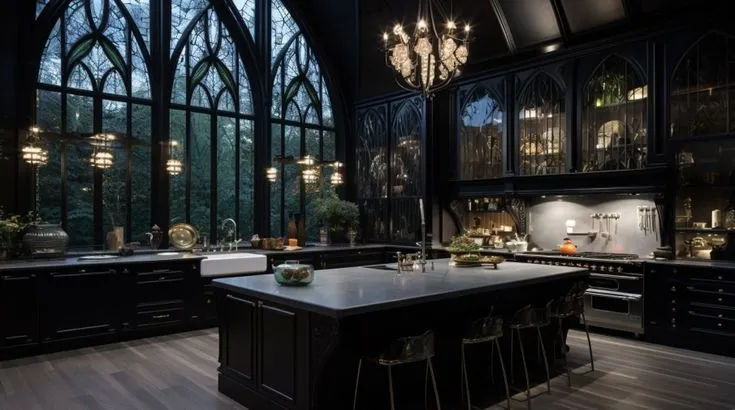The Allure of Gothic Kitchen Decor
Gothic kitchen decor is a captivating design choice that blends historical elegance with a touch of mystery. It’s a style that transcends the ordinary, transforming a utilitarian space into a dramatic and visually stunning environment. This aesthetic, steeped in the romance and grandeur of the Gothic era, offers a unique opportunity to create a kitchen that is both functional and a reflection of your personal style. The use of rich colors, ornate details, and dramatic lighting creates an atmosphere that is both inviting and intriguing, setting it apart from more conventional kitchen designs. Embracing Gothic elements in your kitchen allows you to make a bold statement, showcasing a love for history, artistry, and a touch of the unconventional. The unique appeal of Gothic kitchen decor lies in its ability to create a truly unforgettable space within your home. It’s not just about aesthetics; it’s about creating an experience.
Understanding the Gothic Aesthetic
The Gothic aesthetic is rooted in the architectural and artistic styles of the late medieval period. Think of grand cathedrals, with their soaring arches, stained-glass windows, and intricate carvings. This style is characterized by a sense of drama, with a focus on intricate details, dark colors, and a touch of the macabre. When applied to kitchen design, the Gothic aesthetic translates into a space that is both visually striking and deeply atmospheric. The use of rich, saturated colors, such as deep reds, purples, and blacks, sets the tone for a space that is both elegant and mysterious. Furniture often features ornate carvings, and detailed hardware, contributing to the overall grandeur of the design. Accessories, such as candelabras, wrought iron elements, and antique mirrors, add the final touches, enhancing the Gothic ambiance. The overall effect is a space that tells a story, evoking a sense of history and sophistication.
Key Elements of Gothic Design
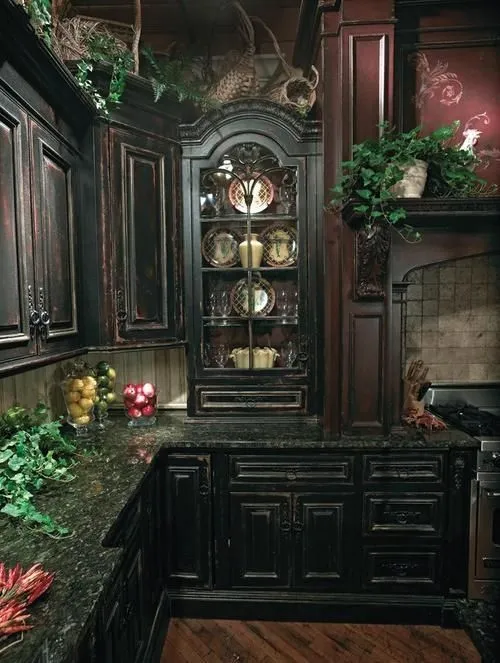
Creating a Gothic kitchen involves understanding the key elements that define the style. These elements work together to create a cohesive and visually stunning space. From the color palette to the choice of furniture and accessories, each detail contributes to the overall aesthetic. Understanding these elements will allow you to successfully incorporate Gothic elements into your kitchen, transforming it into a unique and captivating space. Consider using dark wood cabinets with ornate details, combined with countertops in contrasting colors like marble or granite. Incorporate wrought iron elements in lighting fixtures and hardware, and choose accessories that reflect the style’s historical roots. The key is to balance the various elements to achieve an atmosphere that is both cohesive and aesthetically pleasing. A well-executed Gothic kitchen is a testament to the beauty and enduring appeal of the style.
Dark and Moody Color Palettes
Color is a fundamental aspect of Gothic design. Embrace deep, rich colors such as black, deep reds (like burgundy or crimson), purples (like amethyst or eggplant), and dark greens (like forest or emerald). These colors create a sense of drama and sophistication, immediately setting the tone for a Gothic-inspired kitchen. You can use these colors for cabinetry, walls, or as accent colors. Combining these dark hues with lighter elements, such as marble countertops or metallic finishes, can prevent the space from feeling too enclosed. Always incorporate metallic accents to add a touch of glamour and contrast. Consider painting the walls in a deep charcoal or dark teal and pairing them with lighter-colored furniture to create a balanced and inviting space. The color scheme should evoke a sense of mystery and elegance, reflecting the historical influences of the style.
Ornate and Detailed Furnishings
Furniture plays a crucial role in establishing the Gothic aesthetic. Look for cabinets and furniture with intricate carvings, arched doorways, and detailed hardware. Dark wood, such as mahogany or walnut, is a classic choice, adding to the overall sense of luxury. Consider incorporating a large, imposing dining table with elaborately carved legs and high-backed chairs. The use of wrought iron can add to the aesthetic through chandeliers, pot racks, and decorative details on cabinets or islands. Think about incorporating antique pieces to enhance the historical appeal, and add a sense of authenticity. The key is to choose pieces that are not only functional but also visually stunning, contributing to the overall ambiance of the kitchen. These ornate details are what set Gothic kitchen decor apart, creating a space that is both beautiful and intriguing.
Architectural Features
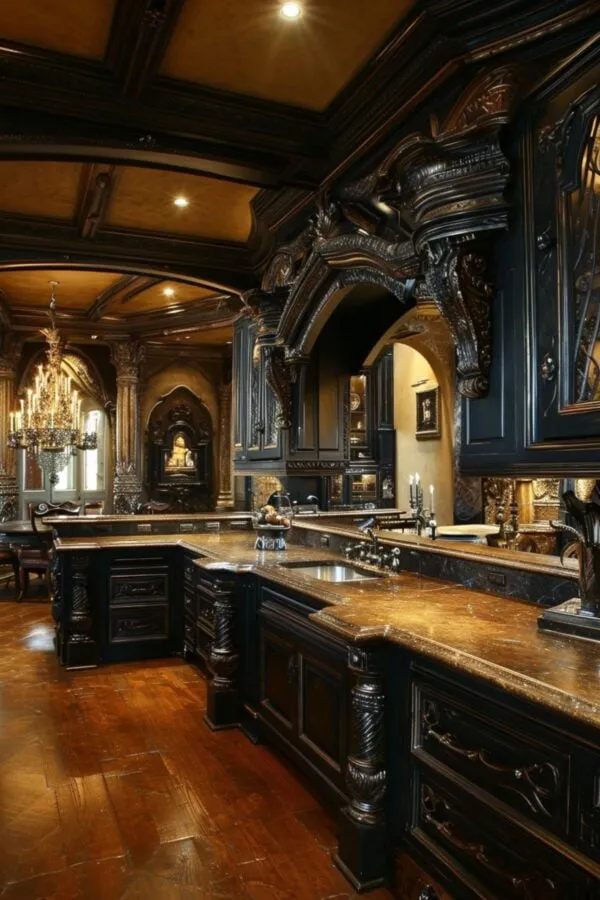
If possible, incorporate architectural features that enhance the Gothic feel. This could include arched doorways, exposed beams, or even a faux fireplace. These elements add character and authenticity to the space. You can use architectural details to highlight the Gothic inspiration. Consider adding decorative molding or paneling to the walls or ceiling. You can also incorporate stained-glass windows or decorative window treatments that enhance the atmosphere of the kitchen. The use of exposed brick or stone can add to the sense of history and texture. Even if you don’t have existing architectural elements, you can incorporate them through strategic design choices. The aim is to incorporate details that echo the grand architecture of the Gothic era, which enhances the overall visual impact of your kitchen.
Incorporating Gothic Kitchen Decor
Incorporating Gothic elements into your kitchen requires a strategic approach to ensure a cohesive and aesthetically pleasing design. This involves carefully selecting the right color schemes, furniture, and decorative accents. It’s about creating a balance between the dramatic and the functional, ensuring the kitchen remains a practical space. The goal is to create a space that is both visually striking and inviting, reflecting your personal style while paying homage to the Gothic aesthetic. Think of each element as a piece of a puzzle, working together to create a complete and immersive Gothic experience. The key is to take your time, carefully consider each detail, and stay true to the essence of Gothic design to create a truly unique and unforgettable kitchen.
Choosing the Right Color Scheme
Choosing the right color scheme is a crucial first step. As mentioned, deep, rich colors are essential. Start by selecting a base color, such as black, deep red, or a dark teal, for your cabinetry or walls. Then, introduce contrasting colors through countertops, backsplashes, or accent pieces. For example, pairing black cabinets with white marble countertops can create a striking contrast. Use metallic accents, such as gold or bronze, to add a touch of glamour and prevent the space from feeling too dark. Consider incorporating a patterned wallpaper or backsplash to add visual interest. When selecting colors, think about the overall mood you want to create – whether it’s dramatic, elegant, or mysterious – and let that guide your choices. Ensure the colors complement each other and reflect the style’s historical inspirations. The color scheme is the foundation upon which the rest of your Gothic kitchen design will be built, so choose wisely.
Selecting Gothic-Inspired Furniture
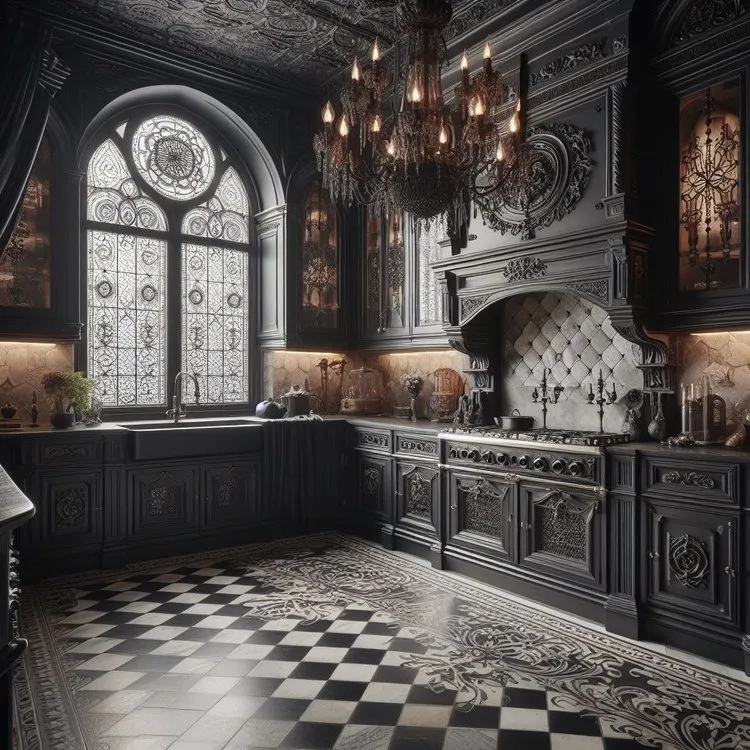
The furniture you choose will significantly impact the overall look and feel of your Gothic kitchen. Look for cabinets with ornate carvings, arched doorways, and dark finishes. Consider incorporating an island with detailed legs or a decorative trim. Dining tables and chairs are also important; opt for a large, imposing table with carved legs, paired with high-backed chairs. The use of wrought iron can add to the Gothic style; consider chandeliers, pot racks, or decorative accents on cabinets. When selecting furniture, focus on pieces that reflect the historical roots of the Gothic style. Don’t be afraid to incorporate antique or vintage pieces to add authenticity and character. The goal is to choose furniture that is both functional and visually stunning, complementing the overall ambiance. Make sure the furniture elements work with the layout of the space, ensuring both aesthetics and functionality are met.
Adding Decorative Accents
Decorative accents are essential for creating a cohesive Gothic kitchen design. Choose accessories that complement the overall aesthetic. Consider incorporating candelabras, wrought iron candle holders, and antique mirrors to add to the dramatic ambiance. Other accents to explore include ornate dishware, antique-style clocks, and decorative vases. Textiles can also play a role; consider using rich fabrics like velvet or damask for window treatments or table linens. When selecting accents, choose pieces that reflect the historical inspirations of the style. Don’t overcrowd the space; instead, select a few key pieces that make a statement. The goal is to create a space that is both beautiful and inviting, enhancing the overall aesthetic and adding the final touches that bring the Gothic kitchen design to life.
Gothic Kitchen Decor Ideas to Inspire
Ready to get inspired? Think about how to make your kitchen a Gothic haven and discover the possibilities of mixing elements of the dark aesthetic with modern design. Gothic kitchen decor can be a fun and satisfying process. The key is to explore the style’s historical roots, embrace dark color palettes, and incorporate architectural and decorative elements. You can create a kitchen that is both visually striking and a reflection of your unique personal style. Whether you prefer a full Gothic immersion or a more subtle touch, the possibilities are endless. With careful planning and attention to detail, you can create a kitchen that is truly unforgettable. Here are a few examples of how to start.
Transforming Your Kitchen into a Gothic Haven
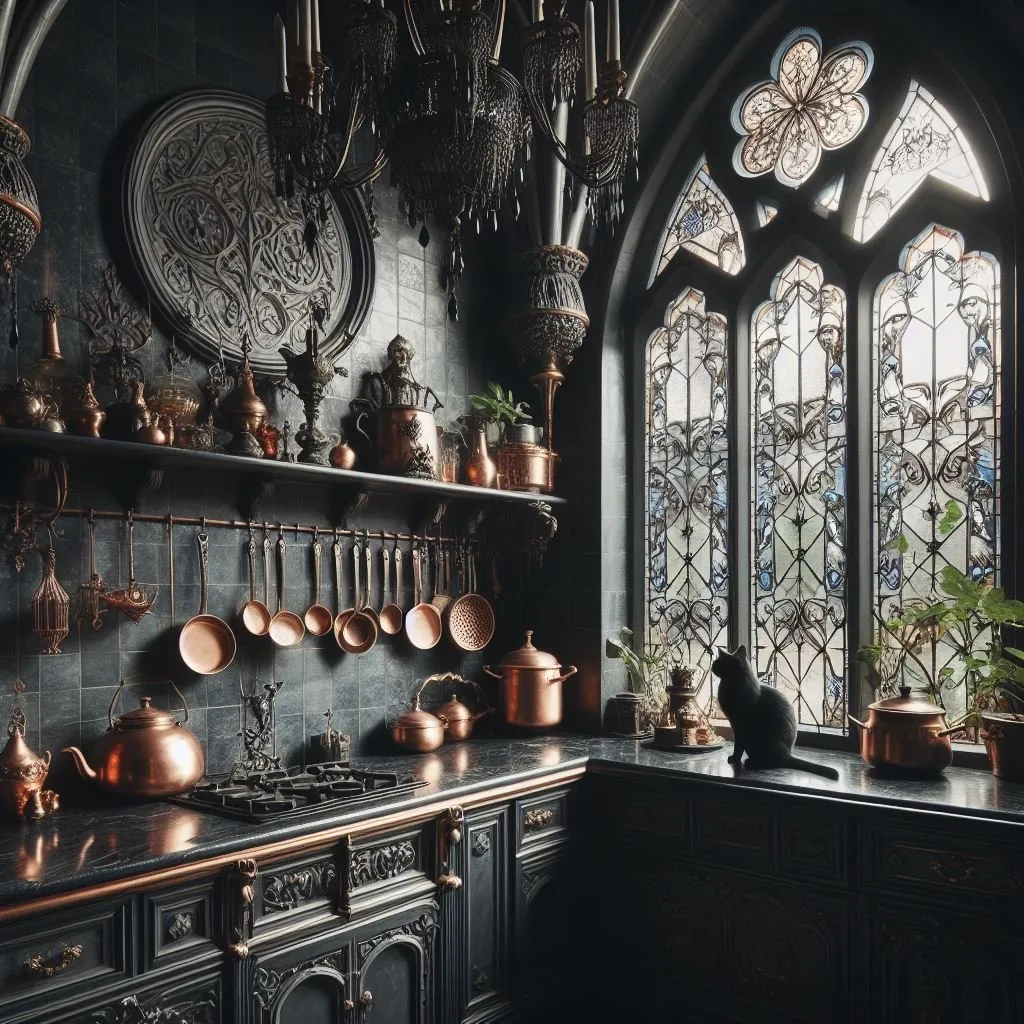
To transform your kitchen into a Gothic haven, start by considering the existing layout and making strategic changes. Replace standard cabinetry with dark-stained cabinets, perhaps in a mahogany or walnut finish, and add detailed hardware. Install a dramatic backsplash, maybe a mosaic tile in a deep red or black. Update the lighting with wrought iron chandeliers or sconces. Consider painting the walls in a deep charcoal, burgundy, or dark teal to set the tone. Introduce gothic furniture, such as a large dining table and chairs with ornate carvings. Finish it all with accessories, like candelabras, vintage mirrors, and gothic-inspired dishware. The key is to create an immersive experience. Your kitchen will become a space that is both functional and a testament to your unique style. Be creative and explore the possibilities, creating a space that’s uniquely yours.
Implementing Gothic Elements in a Modern Kitchen
For those who want a more subtle touch, integrating Gothic elements into a modern kitchen is an excellent approach. Start by incorporating a dark color palette, such as dark gray or black cabinetry, and contrasting them with lighter countertops. Add wrought iron hardware, such as handles and knobs, and install a dramatic chandelier over the island. Introduce Gothic-inspired art, such as paintings or mirrors with ornate frames. Consider incorporating gothic patterns or details in the backsplash or wallpaper. The goal is to create a balance between the modern and the gothic. You can integrate elements of the dark aesthetic without completely overhauling your kitchen. By being mindful of the existing design, you can create a space that feels both current and steeped in the elegance of the Gothic style.
Designing a Gothic Kitchen on a Budget
Designing a Gothic kitchen on a budget is possible with some creative solutions. Start by repurposing existing furniture; you could repaint your cabinets in a dark color and change the hardware. Search for affordable, Gothic-inspired furniture online or in thrift stores. Use paint to transform walls and add accent details to cabinets. Accessorize with budget-friendly decor, such as thrift store finds or DIY projects. Focus on creating a cohesive color scheme, incorporating dark and moody colors. Lighting can be updated with affordable wrought iron fixtures. Use wallpaper or stencils to create dramatic accents. With creativity and resourceful shopping, you can achieve the look you desire without breaking the bank. A budget-friendly approach allows you to embrace the unique charm of Gothic decor.
